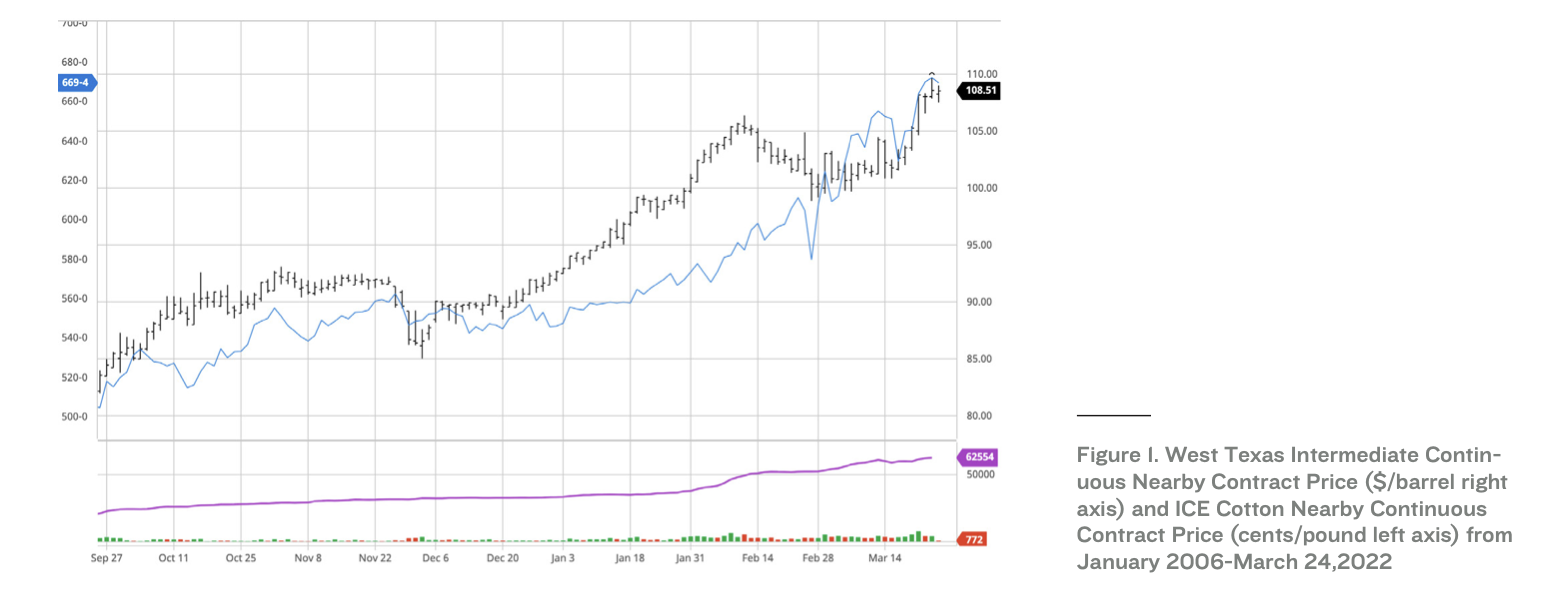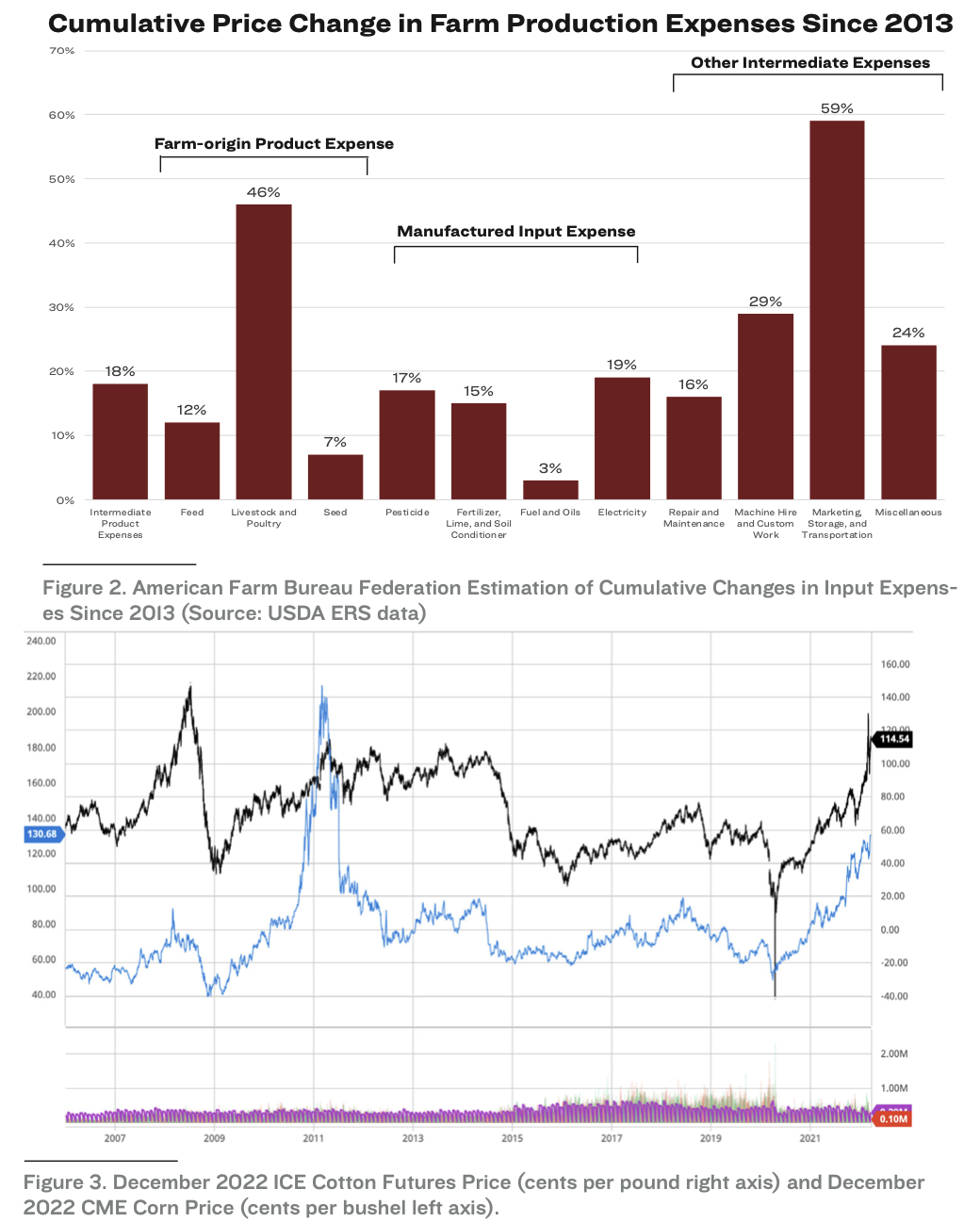
“May you live in interesting times” is an old Chinese curse, not well wishes, and our times are interesting. COVID, subsequent supply chain issues, inflation, drought, and Russia’s invasion of Ukraine have all combined in a perfect storm of a mess and agriculture is in the center of that storm. How do we approach this time with clear eyes and a plan? We cannot control the world much less all the variables affecting our decisions. But we can focus on a few key variables that have the most impact.
Energy Prices. Energy prices undergird almost all a farm’s production expenses in one way or another. Figure 1 shows both oil and cotton price.
First, oil prices are quite high but not at unprecedented levels. Second, while energy prices have risen, cotton price has tracked that rise well. This seems little consolation as you fill your diesel tanks or purchase inputs derived from petroleum, but cotton price has been a relatively good hedge against oil/energy price changes over time. This year is no exception.
Input Prices. While energy undergirds most inputs, it does not tell the complete story. The American Farm Bureau Federation compiled the cumulative rise in input expenses since 2013 (Figure 2).
Across the board, production expenses are higher as one would expect. And, of course, not all expenses hit all farms the same. But using Hockley County Texas as an example, average lint revenue for cotton has not grown…at all…since 2013. There has, no doubt, been some good years in this time frame, and this year if a crop is produced will be one of the best in terms of revenue, but average per acre revenue has been stagnant since the early 2000s.
Managing input price risk is often difficult. One can pre-purchase diesel, seed, chemicals, etc. But there is uncertainty in normal years of whether those prices would rise or fall prior to use. In 2022, there is the added uncertainty of whether those products will even be available for the growing season. And given the relative output price changes that have rapidly occurred, planning for inputs to match the ultimate crop planted adds to that uncertainty.
Output Price. The price of cotton has risen substantially (Figure 3) as well as other crops (corn is compared in the graph.)
There have been (and remain) many pricing opportunities to secure much higher than average cotton price. Of course, one must make a crop to reap those returns. However, one cannot control the weather and playing a guessing game can leave you unprotected should prices change directions (and inputs are already committed, so price declines there will not help the bottom line).
Risk Management Options. So, what do we do? Price is high but so are input costs. There is a lot of uncertainty about weather, geopolitical events, inflation/recession and product demand, etc. Here are a few thoughts about options on the table and general approaches to risk management.
Manage risk first, seek added profits second. The continuation of your business is the single most important metric of success, not the few extra cents you might get by “playing the market”. Know where your breakeven is given input costs and expected yields. If you can price above that point, buy some protection either through futures or options. Even users of marketing pools can use puts to protect against downside price moves that lower the pool average price or calls to capture upside price moves while capturing the pool average for base revenue. The bottom line is that you should not risk your base revenue in hopes of capturing that uncertain upward price move. This also goes for inputs. Purchase some base needs early. Locking in some of your needs also gives you a much better estimate of your breakeven price for marketing purposes.

Pay your taxes and bank profits. We are always tempted when a crop turns out great to attempt to hide our taxes through equipment purchases or other investments in farm expenses. If you NEED that new plow or stripper, get it. But do not make long-term investment decisions to hide taxes. Building cash reserves is a highly efficient way to reduce farm financial risk, dependency on borrowed operating expenses, etc., and allows the building of liquid assets for retirement planning. Your accountant will help you minimize your tax liability if that is what you tell them to do…don’t. Balance your short- and long-term planning to help you through the leaner times.
Utilize insurance and challenge your agent for options. The insurance program is not a “cure all” but is an effective risk management tool. Do not be complacent and “just do what I always do” when it comes time to buy insurance. Challenge your agent about what options are available. Do not buy insurance you do not need to manage your risk or have coverage levels that have larger payoffs but higher premiums just to get the payoff. Again, manage risk first, think about added profits second.
It is difficult to talk about “general” rules of farm management. Individual tolerance for risk, physical farm characteristics, age and family dynamics, etc., all make individual decisions, well, individual. Challenging markets are nothing new to farming. But long-term success requires long-term thinking. We are often so caught up in the day-to-day and season-to-season challenges that we forget to think about how decisions today will impact future choices. We are also often “shamed” through peer pressure to believe that one-size-fits-all decision-making is the rule. For example, some farmers are content to place their cotton in the pool and focus on production decisions. Others actively market their crop through contracts, futures and options, etc. We should not feel that one mode is superior to others. Rather, different modes serve different purposes and have their own costs/benefits of use. Focus on those things that make the most sense for your operation, manage your risk the best you can, utilize the tools that are available to you, plan for your future, and seek help in understanding things when you need it. There is no magic formula for success but paying attention to these things can help you live in interesting times.


